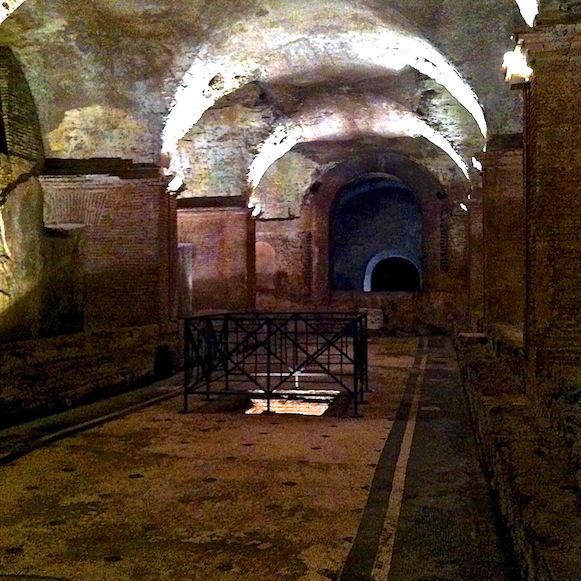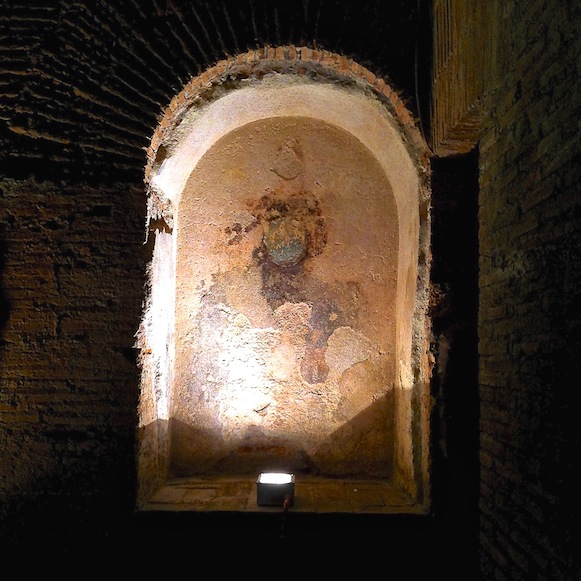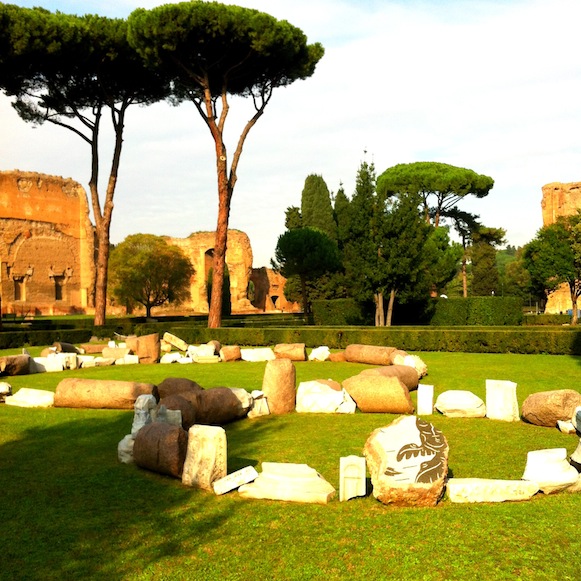Mithraeum at the Baths of Caracalla
Any time an ancient site opens, or better yet, reopens, it is a cause for celebration. Once again, we are permitted to literally step into history and equally watch as history makes itself thanks to continued cultural heritage endeavors and financial support. This is especially the case with the recent opening of the Mithraeum of the Baths of Caracalla. Originally discovered in 1912, this mithraeum is considered the largest documented gathering space for the worshippers of Mithras. (Mithras was a Persian god in vogue with the military and mostly lower class men, in the second and third centuries AD.) The mithraeum, approximately 23 meters long and 10 meters wide with a soaring cross-vaulted ceiling, can be only roughly dated by the two main events associated with the bath complex: the mithraeum was certainly created after the complex was completed in AD 217, and it was probably no longer in use when the aqueduct supplying the complex was cut during the Greco-Gothic Wars in 537. In reality, it probably went out of use long before 537, since most scholars hold that Christianity had supplanted Mithraism as a “religion for the masses” by the early 4th century.
Today, a visit to the mithraeum can be considered a brief one, as what is available to us are primarily two chambers: a small square ante-chamber and the main rectangular meeting hall. Apart from a recently-restored fresco of the god (missing the face, unfortunately – presumably hacked away by Christians), there is very little left of the decoration, which was probably very lavish. The well-preserved podium structures on either long side, on which the worshippers reclined during ritual meals, give an excellent idea of the context and purpose of the shrine. Certainly the most intriguing feature is the small tunnel that runs under the center of the main hall into an adjoining room, where there is an entrance/exit with staircase; this has been identified with some controversy as the fossa sanguinis, the ritual pit over which the bull at the center of the Mithraic mythology was slaughtered, bathing one or more initiates in its blood.
Its location, off a dirt road adjacent to the main entrance, is part of a subterranean area of the Baths of Caracalla. The mithraeum space is just one part of the massive, sprawling system of underground corridors that honeycombs the large artificial platform supporting the Baths of Caracalla. Beneath the thermae complex lies a warren of tunnels with furnaces, stoked by slaves, and storage areas for supplies, including wood. Though access to these tunnels is today only partial, there are confirmed plans to extend the conservation and restoration work to make more of these areas accessible, including a substantial area dedicated to grinding grain using the water that passed through the baths.
It is important to note that Rome and its port city Ostia Antica have the largest number of preserved mithraea of any city in the Roman empire—scholars estimate that Rome once had 700 Mithraic shrines, while Ostia boasts 17 confirmed shrines—but only a small percentage of these are accessible to the public. More money and more investment will only benefit conservation and access for tourists who are increasingly willing to explore the more remote corners of the ancient city.
Visiting the Mithraeum is also an excellent excuse to head into the Baths of Caracalla to walk among the monumental structure and also enjoy a contemporary art installation by Italian artist Michelangelo Pistoletto. Three interlocking circles made up of fragrments of ancient marble and stone, Terzo Paradiso is the new symbol of infinity created by Pistoletto originally for the 2005 Venice Biennale, and an ongoing, collaborative project in varying venues and media. The new infinity symbol is all to action for the active and conscious need to create a “third paradise” to combat and transplant the artificial world we are celebrating today. Too deep? Too artsy? In any case, the site specific installation (through January 6, 2013) is a beautiful juxtaposition of contemporary and ancient, especially with the backdrop of the majestic pines and Baths of Caracalla.
How to visit: advance reservation for a guided tour to Mithraeum at the Baths of Caracalla will cost 16.50 euro and does not include entrance to the Baths. Here’s a tip- try the unguided visits at 10:00, 10:30, and 1:00, which are practically empty on weekdays. How? Buy the regular ticket (6.00 euros) at the ticket booth and pay a 1.50 euro supplement to visit the Mithraeum at one of those three times.













Pingback: Mithraeum at the Baths of Caracalla - Roman News and Archaeology
Pingback: Links for the Week of 6 January | CANEns: The CANE Blog and Newsletter